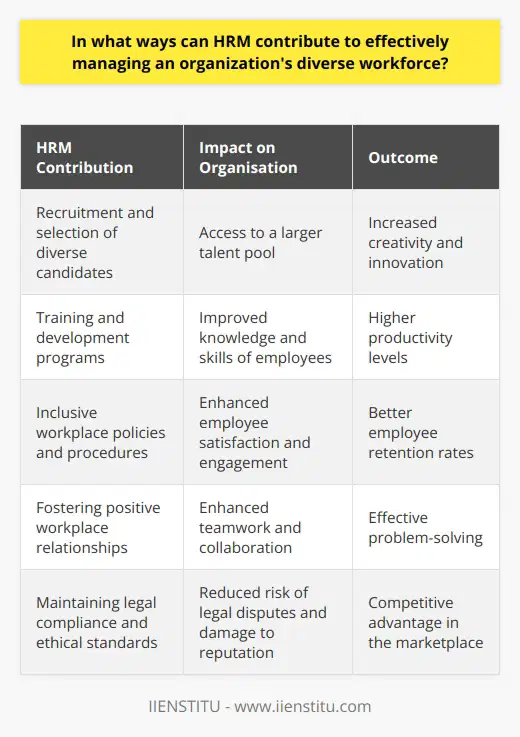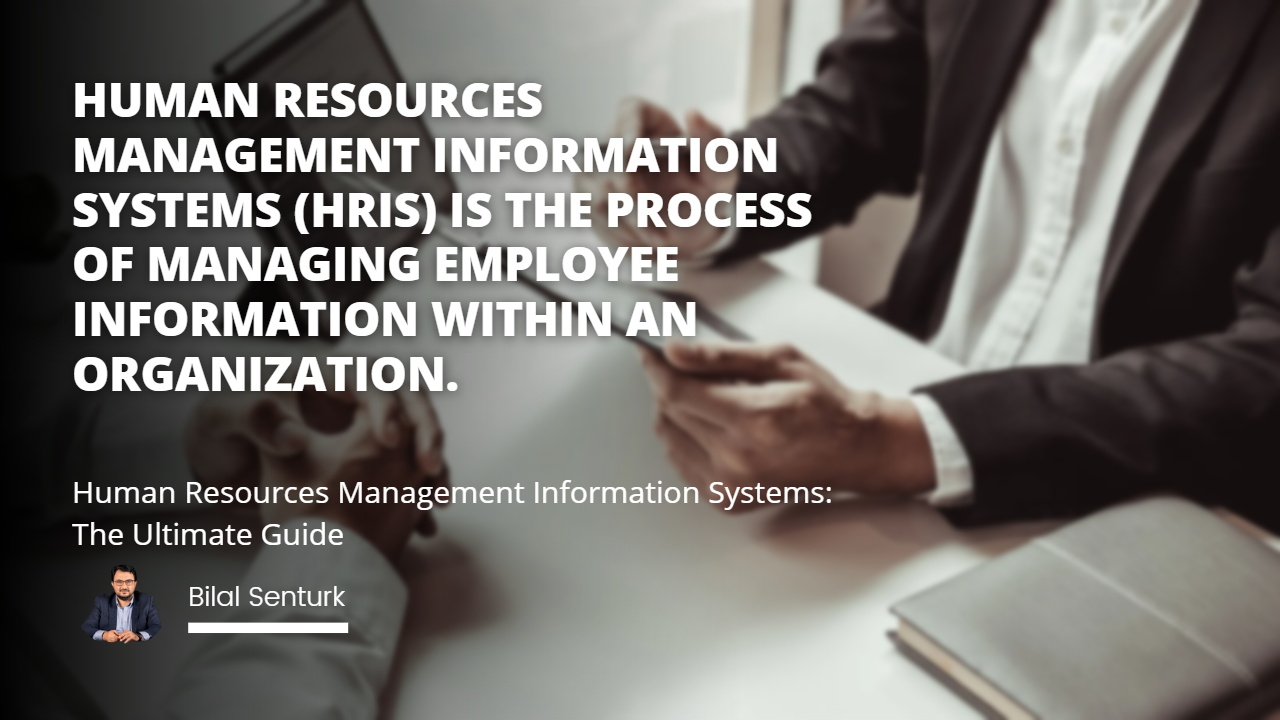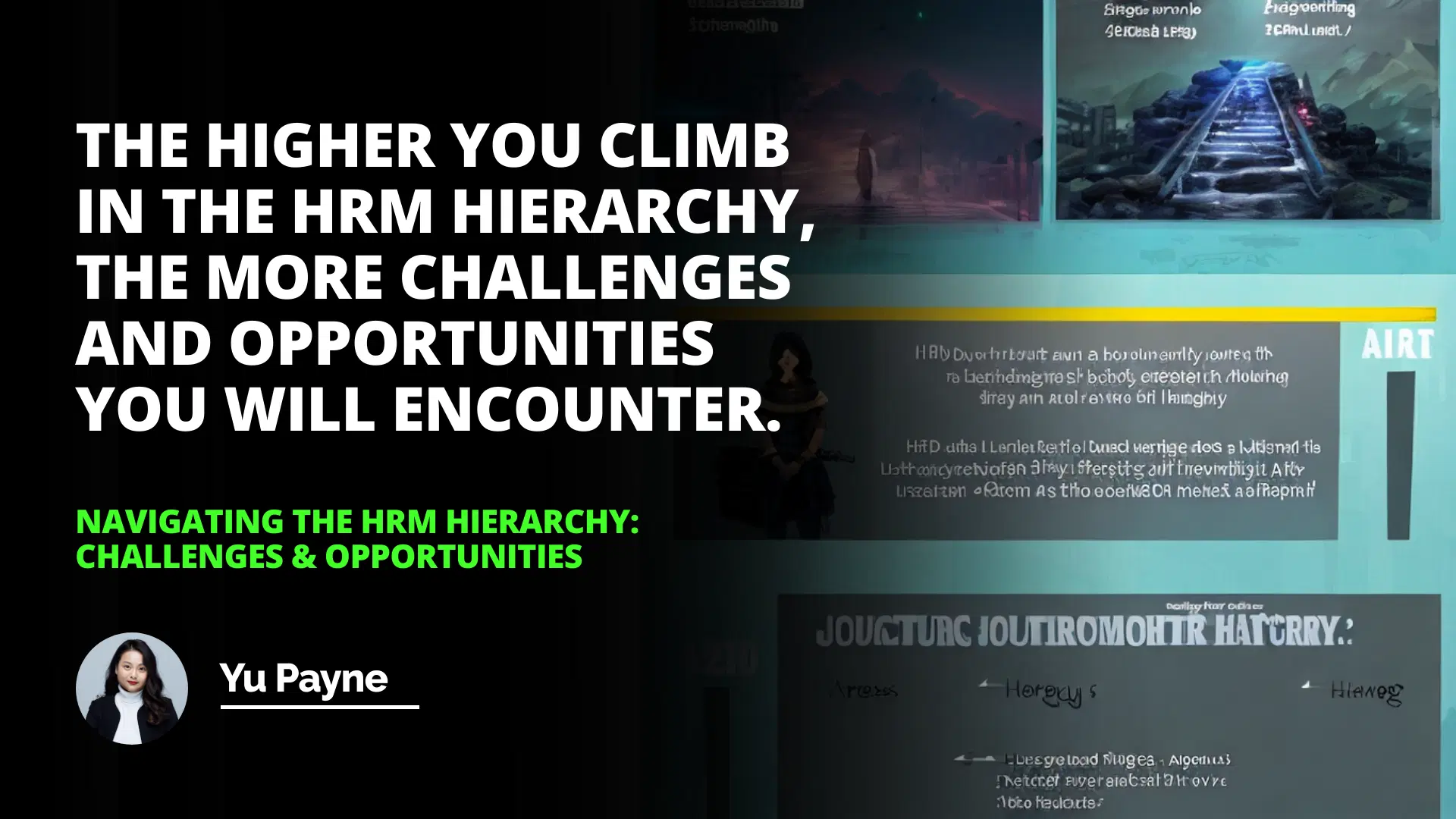
You know, when I first stepped into the world of human resources, I had this naive belief that I'd be directly impacting people every single day. I imagined open doors, seamless communication, and swift decision-making that would benefit both the employees and the organization. However, as I climbed higher up the ladder in the human resource HR hierarchy, I began to realize that things weren't as straightforward as I had hoped. The multitiered HRM hierarchy presented both challenges and opportunities that I hadn't anticipated.
Navigating the Complexities of a Multitiered HRM Hierarchy
Introduction
Challenges in a Multitiered HRM Hierarchy
Opportunities in a Multitiered HRM Hierarchy
The Risk of Returning to the "Dumping Ground"
Conclusion
When I was just starting out, I remember a colleague telling me, "The higher you climb, the trickier it gets." At the time, I brushed it off, thinking I was prepared for any obstacle. But boy, was I in for a surprise!
Challenges Faced
One of the first challenges I encountered was the delay in decision-making. I recall an instance where we needed to implement a new policy to improve employee engagement. It was a simple enough idea, or so I thought. But the proposal had to pass through what felt like an endless chain of approvals.
1- Multiple Signatures Required: The document had to be signed off by not just my immediate supervisor but also by several managers up the chain.
2- Lack of Understanding: Some of these higher-ups weren't even from HR human; they were executives overseeing various departments. They didn't fully grasp the nuances of the HRM hierarchy or the specific needs of our employees.
3- Communication Gaps: There was a noticeable lack of communication between different levels. Those at the top seldom consulted with those of us on the ground.
I remember feeling quite frustrated. We'd have meetings about meetings, and yet nothing seemed to progress. The red tape was real, and it was underlined by a culture of excessive bureaucracy.
Moreover, there was this unspoken hesitation among my peers. Employees near the lower end of the hierarchy often felt their voices didn't matter. They were reluctant to share their insights or challenge decisions, fearing it might jeopardize their standing. This led to a stifled environment where innovation was scarce.
The "Dumping Ground" Phenomenon
Another significant risk was the potential of HR becoming the proverbial "dumping ground". This happens when:
Non-HR Executives Make HR Decisions: Without proper HR expertise, decisions can be misaligned with the organization's values and employee needs.
Lack of HR Representation: HR professionals aren't adequately represented in strategic meetings, leading to a disconnect between strategic human resource management and actual practice.
I once witnessed a situation where a major decision about employee benefits was made without consulting the HR team. The result? A policy that didn't comply with legal standards and caused an uproar among staff. It took months to rectify the mistake, causing unnecessary strain on human resources resources and trust.
Embracing the Opportunities
But it's not all doom and gloom! Despite these hurdles, there's a silver lining. The multitiered HRM hierarchy can offer numerous opportunities for growth and improvement.
Structured Decision-Making
Firstly, the hierarchy provides a structured approach to decision-making.
Checks and Balances: Multiple levels of approval can prevent hasty decisions that might not be in the best interest of the organization.
Diverse Perspectives: Having various stakeholders involved brings different viewpoints to the table, enriching the final outcome.
For example, when we finally implemented that employee engagement policy I mentioned earlier, the feedback from different departments helped us fine-tune it. The result was a program that was more inclusive and effective than our original proposal.
Professional Development
Secondly, the hierarchy creates avenues for employees to develop their skills and knowledge.
Mentorship Opportunities: Senior staff can mentor juniors, sharing invaluable insights and experiences.
Cross-Functional Collaboration: Working with different levels encourages understanding of various aspects of the business.
I personally benefited from this when I was assigned to a cross-departmental project. Not only did I learn about optimize supply chain management process tips, but I also gained insights into how HR strategies align with broader business goals.
The higher you climb in the HRM hierarchy, the more challenges and opportunities you will encounter.
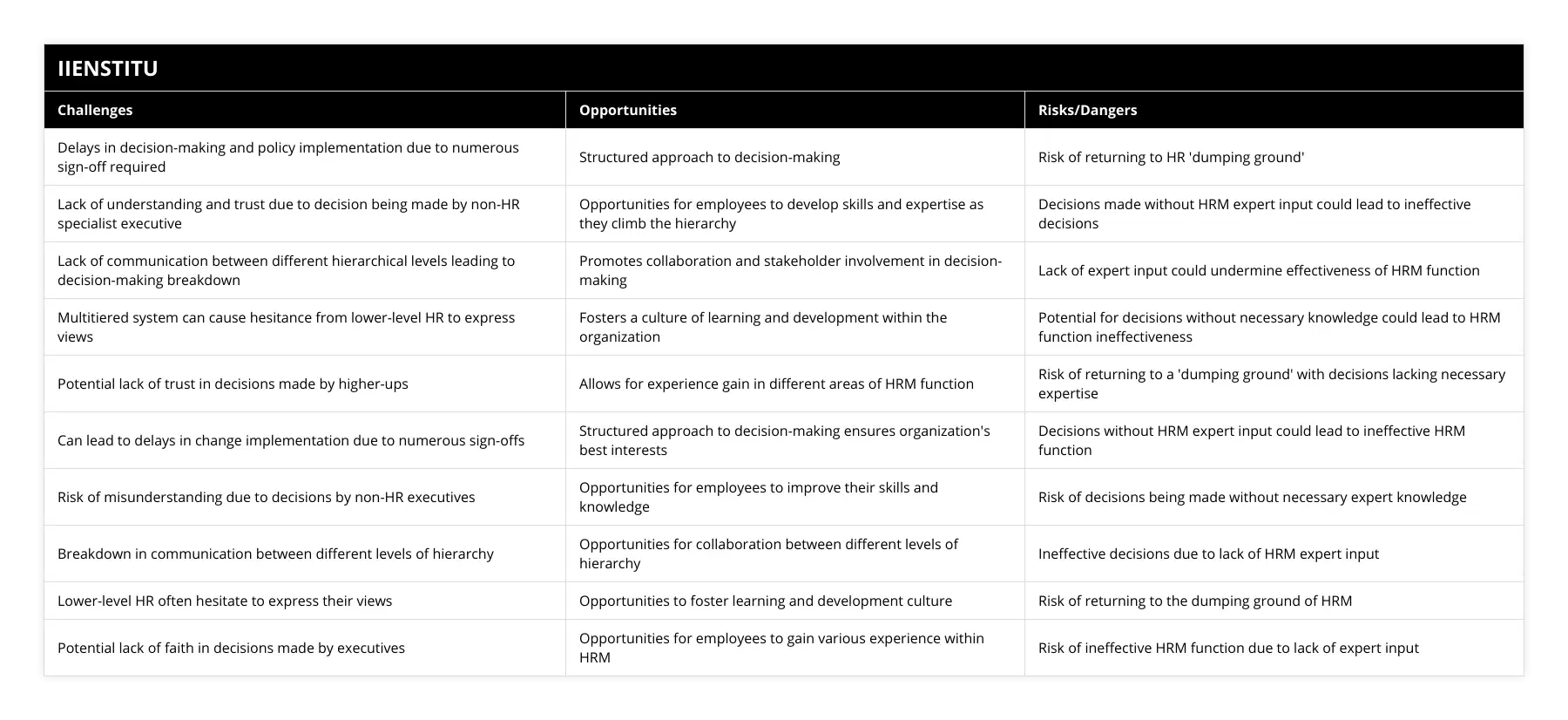
Fostering Collaboration
Lastly, a multitiered hierarchy can enhance collaboration.
Interdepartmental Cooperation: Regular interaction with other departments ensures that HR strategies are aligned with the overall company direction.
Unified Goals: Shared objectives promote teamwork and a sense of unity.
By collaborating closely with the supply chain team, for instance, we were able to develop training programs that improved efficiency and productivity. This alignment of human resources and operational goals exemplifies strategic HR management at its best.
Mitigating the Risks
To prevent returning to the "dumping ground" scenario, it's crucial to address the underlying issues.
Enhancing Communication
Open Forums: Encourage open dialogue between all levels of the hierarchy.
Feedback Mechanisms: Implement regular surveys and suggestion boxes where employees can voice their opinions anonymously.
I recall instituting a monthly human resources information session where anyone could ask questions or raise concerns. This simple initiative significantly improved trust and transparency.
Empowering HR Professionals
Autonomy: Give HR professionals the authority to make decisions within their expertise.
Representation: Ensure HR has a seat at the table in strategic meetings.
By advocating for HR's involvement in executive decisions, we ensured that policies were employee-centric and legally compliant.
Continuous Learning
Training Programs: Offer regular training to keep everyone updated on best practices.
Resource Allocation: Provide adequate human resources resources to support HR initiatives.
We invested in professional development courses, which not only improved our team's capabilities but also signaled the organization's commitment to human and resource development.
Reflecting on Personal Experiences
Looking back, I realize that every challenge was a learning opportunity. Navigating the multitiered HRM hierarchy taught me patience, diplomacy, and the importance of effective communication. There were times I felt like I was stuck in a never-ending loop of approvals, but those moments strengthened my resolve to make a positive impact.
I also realized the importance of each facet of HR, from compliance to what we casually called human rec—our shorthand for human recruitment. Every piece plays a part in the larger puzzle of organizational success.
I remember once, after a particularly grueling week, a junior colleague approached me. She said, "Thank you for pushing through with the policy changes. It has really made a difference in how we approach our work." That simple acknowledgment made all the bureaucracy worth it.
Conclusion
In wrapping up, the journey through the human resources hierarchy is akin to a winding road filled with both obstacles and scenic views.
Challenges like delays and communication gaps test our resilience.
Opportunities for structured decision-making and professional growth enrich our careers.
But perhaps most importantly, by recognizing and addressing the risks—like the potential of reverting to a "dumping ground"—we can strive to create a more effective and responsive HR function.
After all, at the heart of human resource HR, it's all about people. By fostering an environment of trust, open communication, and continuous learning, we can ensure that our organizations not only survive but thrive.
So, if you're climbing the HR ladder, remember: each step brings new lessons. Embrace them, and you'll make a lasting difference in your organization.
References
Armstrong, M. (2020). Armstrong's Handbook of Human Resource Management Practice. Kogan Page Publishers.
Ulrich, D., & Brockbank, W. (2005). The HR Value Proposition. Harvard Business Press.
Mathis, R. L., & Jackson, J. H. (2019). Human Resource Management. Cengage Learning.
Schuler, R. S., & Jackson, S. E. (2007). Strategic Human Resource Management. Wiley-Blackwell.
Frequently Asked Questions
What challenges are associated with navigating a multitiered HRM hierarchy?
Human resource management (HRM) is a complex and multifaceted field of study. It involves various activities and responsibilities and requires understanding a wide range of topics and theories. As such, it can be difficult to navigate the multiple levels of the HRM hierarchy. This article will explore some challenges associated with navigating a multitiered HRM hierarchy.
One of the significant challenges associated with navigating a multitiered HRM hierarchy is the complexity of the structure itself. For example, an HRM department may have different levels of responsibility and authority, such as executive-level, mid-level, and entry-level roles. Each hierarchy level may have its duties, regulations, and policies. This can make it difficult for individuals to understand the different roles and responsibilities within the organization and to ensure they take the appropriate steps to ensure compliance.
Additionally, multitiered HRM hierarchies can create a sense of confusion and fragmentation within the organization. This can lead to misunderstandings and conflicts between individuals as they attempt to navigate the various levels of the hierarchy. This can be particularly problematic when individuals at different levels of the hierarchy are unfamiliar with one another’s roles and responsibilities. It can also lead to a lack of communication and coordination between different departments, leading to misunderstandings and missed opportunities.
Finally, multitiered HRM hierarchies can create a sense of inequality and favoritism within the organization. This can lead to unfairness and resentment among employees, as those at higher levels of the hierarchy may be given preferential treatment or access to resources unavailable to those at lower levels. It can also lead to a lack of trust between individuals, as employees may feel that decisions are being made without their knowledge or input.
Overall, navigating a multitiered HRM hierarchy can be a complex and challenging task. Organizations must ensure that their HRM structures are clear and well-defined and that all individuals understand their roles and responsibilities. Additionally, organizations should strive to create an environment of fairness and equality, where all employees are given equal access to resources and opportunities. By doing so, organizations will be better positioned to maximize their resources and ensure optimal performance.
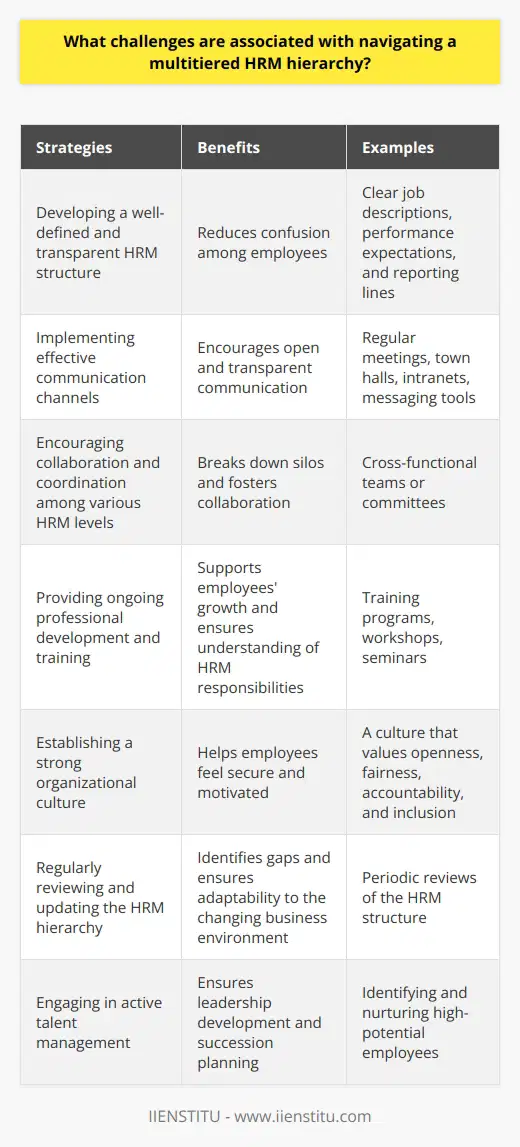
What opportunities can be found in a multitiered HRM hierarchy?
Human resource management (HRM) is critical to any successful business. It is responsible for the recruitment, retention, and development of an organization’s human resources. As such, HRM is a critical factor in determining the success of any organization. An effective HRM structure is well-organized, efficient, and effective. A multitiered HRM hierarchy can effectively ensure that the organization can manage its human resources effectively.
A multitiered HRM hierarchy can provide several opportunities for an organization. It can give a clear structure for communication and decision-making, as well as for the allocation of resources. This can help ensure that the organization can meet its strategic goals and objectives. Additionally, a multitiered HRM hierarchy can provide a platform for the organization to assess and measure its human resources. This can help to ensure that the organization can identify areas where it needs to improve and where it is performing well.
Another opportunity that can be found in a multitiered HRM hierarchy is the ability to create a sense of organizational unity. This can be achieved through a unified approach to managing the organization’s human resources. This can help to ensure that all employees are aware of the organization’s goals and objectives and are working towards them. Additionally, a unified approach to HRM can help to ensure that the organization is able to respond quickly and effectively to changes in the environment.
Finally, a multitiered HRM hierarchy can also provide an opportunity for the organization to implement an effective HRM system. This can include the development of an effective recruitment process and the result of an effective performance management system. In addition, a multitiered HRM hierarchy can also allow the organization to develop a practical training and development system. This can help to ensure that the organization can provide its employees with the necessary skills and knowledge to be successful.
In conclusion, a multitiered HRM hierarchy can provide several opportunities for an organization. It can give a clear structure for communication and decision-making, as well as for the allocation of resources. Additionally, it can provide a platform for the organization to assess and measure its human resources, create a sense of organizational unity, and implement an effective HRM system. As such, a multitiered HRM hierarchy can be an effective way for an organization to manage its human resources effectively.
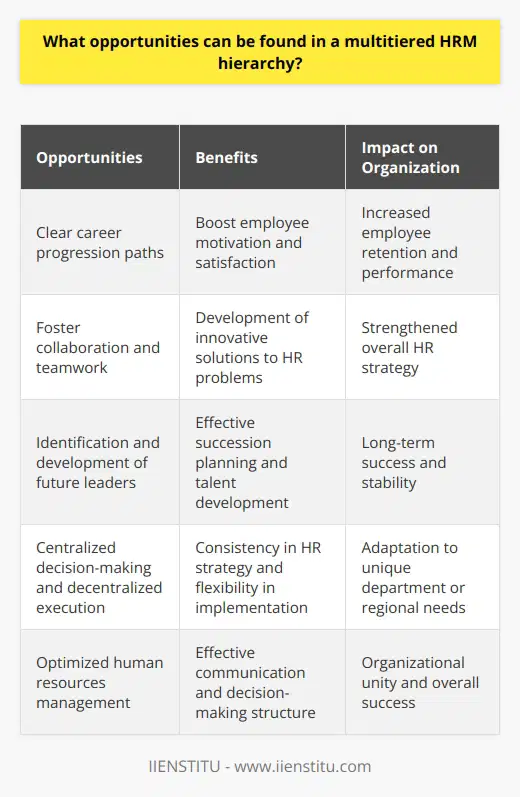
What risks are associated with returning to the “dumping ground” in an HRM hierarchy?
The “dumping ground” concept in Human Resource Management (HRM) hierarchies has been debated for many years. The term refers to assigning low-priority tasks or projects to employees or groups of employees in a hierarchical structure, regardless of their skill set or aptitude for the job. While this practice may be beneficial in the short term, it can carry significant risks if used persistently.
One of the risks associated with returning to the “dumping ground” in an HRM hierarchy is the potential for employees to become disgruntled and resentful. Suppose a particular employee or group of employees is consistently given low-priority tasks. In that case, they may begin to feel that their skills and abilities are not being used to their fullest potential. This could lead to a decrease in productivity and morale, which can hurt the organization's overall performance.
In addition, returning to the “dumping ground” in an HRM hierarchy can also lead to a lack of motivation among employees. If employees feel their skills are not being fully utilized, they may become less enthusiastic about their work and feel their efforts are not being recognized or rewarded. This can lead to decreased job satisfaction, leading to a reduction in productivity.
Finally, returning to the “dumping ground” in an HRM hierarchy can decrease creativity and innovation. If employees are constantly given tasks that are seen as low-priority, they may become less willing to take risks or think outside the box. This can lead to a less dynamic and less productive organization, as innovative ideas and solutions are not being explored.
In conclusion, the risks associated with returning to the “dumping ground” in an HRM hierarchy are significant. It can lead to decreased morale, motivation, and creativity, all of which can negatively impact the organization as a whole. Therefore, it is essential for organizations to be aware of these risks and to avoid returning to the “dumping ground” in an HRM hierarchy.
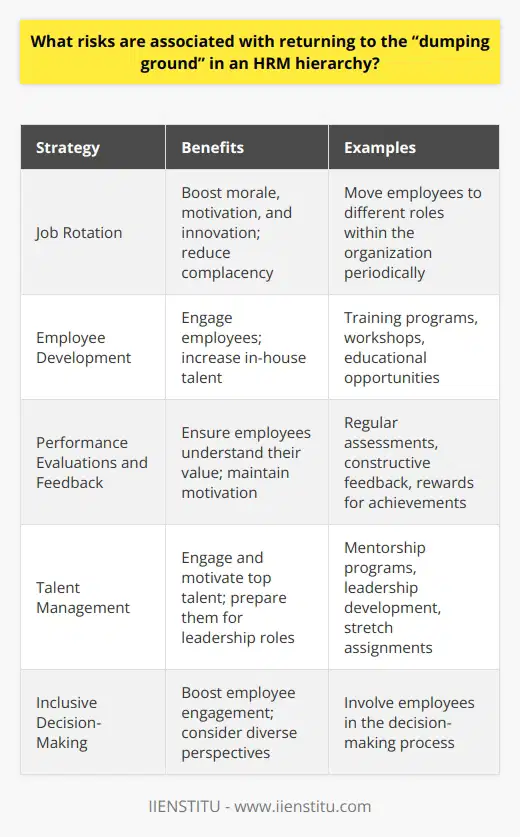
What is the role of HRM in addressing and overcoming contemporary workforce challenges?
Role of HRM in Overcoming Workforce Challenges
HRM plays a crucial role in overcoming contemporary workforce challenges. The first of these challenges is diversity and inclusion. HRM ensures a workplace that respects and includes differences, recognizing the benefits of diversity. They also ensure compliance with laws and regulations, preventing discrimination.
Recruitment and Retention
Another paramount task of HRM is effective recruitment and retention. HRM develops policies, provides training and offers benefits that attract and retain skilled employees. Also, they use various strategies to create a motivated and engaging work environment.
Adjusting to Technological Changes
The rapid advancement of technology presents another challenge. HRM helps employees adapt to these changes through continuous learning and development programs. They also champion for the adoption of technologies that enhance productivity.
Performance Management
Performance management is another role HRM plays. HRM establishes performance standards and evaluates employee performance objectively. They determine areas for improvement and provide opportunities for professional growth.
Responding to Globalization
Lastly, with globalization, HRM develops strategies to deal with multi-cultural, diverse workforce. They ensure that organizational culture respects and supports international workers.
In conclusion, the role of HRM in overcoming workforce challenges is expansive and paramount. They ensure diversity, manage recruitment and retention, adjust to technological changes, manage performance, and respond to globalization. Through these actions, HRM becomes essential in addressing and overcoming the challenges of the contemporary workforce.
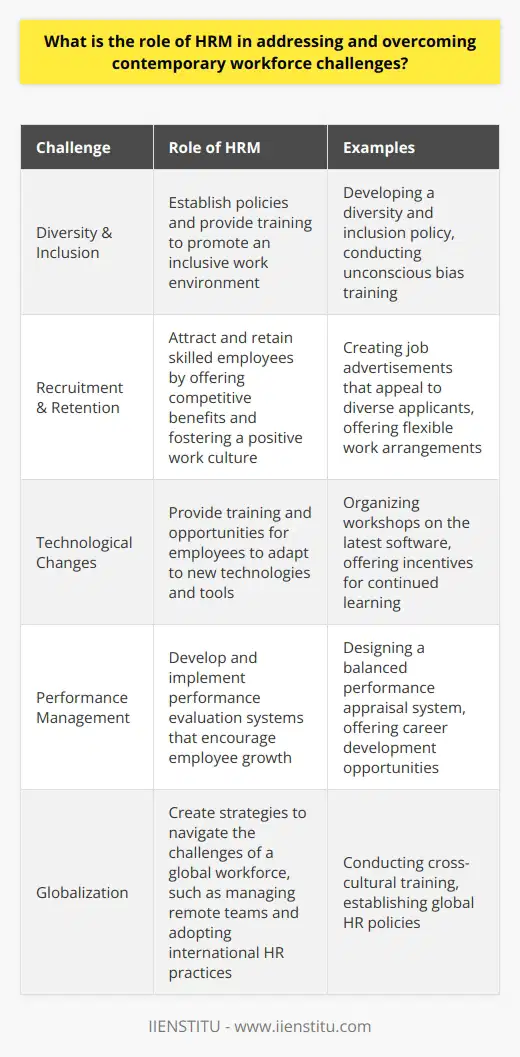
How can HRM help managers maintain a balanced and efficient organizational hierarchy?
Organizational Hierarchy Maintenance through HRM
HRM (Human Resource Management) serves as a key mechanism for leadership in shaping and maintaining a balanced and efficient organizational hierarchy. It caries this out through several strategies.
Recruitment and Selection
A primary function of HRM involves recruiting and selecting the right employees. In order to maintain a well-functioning hierarchy, HRM should hire candidates who fit well into the organizational structure. This should be both in terms of experience levels and ability to work within the existing team dynamic.
Performance Assessment and Fair Evaluation
HRM can support managers in retaining a balanced hierarchy by carrying out regular and objective performance evaluations. Effective performance management can help pinpoint areas of inefficiency in the hierarchy. It can also identify employees who are under-performing or over-performing in their roles.
Training and Development Programs
HRM should also offer training and development programs that improve the knowledge and skills of employees. This can make them more effective in their roles and help maintain an efficient hierarchy. This can also help keep employees motivated and minimize the risk of high turnover rates that can disrupt the organizational hierarchy.
Conflict Resolution and Communication
HRM can also assist managers by implementing effective communication and conflict resolution mechanisms. These can help address any issues that arise within the hierarchical structure. This in turn, ensures smoother operations and maintains balance within the organization.
The Role of HRM in Leadership
Ultimately, HRM supports managers in leading and directing employees in a manner that respects the organizational hierarchy. HRM does this by ensuring managers have the right tools and support to lead their teams effectively. This includes helping them manage team dynamics, motivate their employees, and resolve any potential conflicts.
In summary, HRM plays a crucial role in maintaining a balanced and efficient organizational hierarchy. This is achieved through thoughtful recruitment, regular performance evaluation, enforcing training and development, as well as facilitating effective communication.
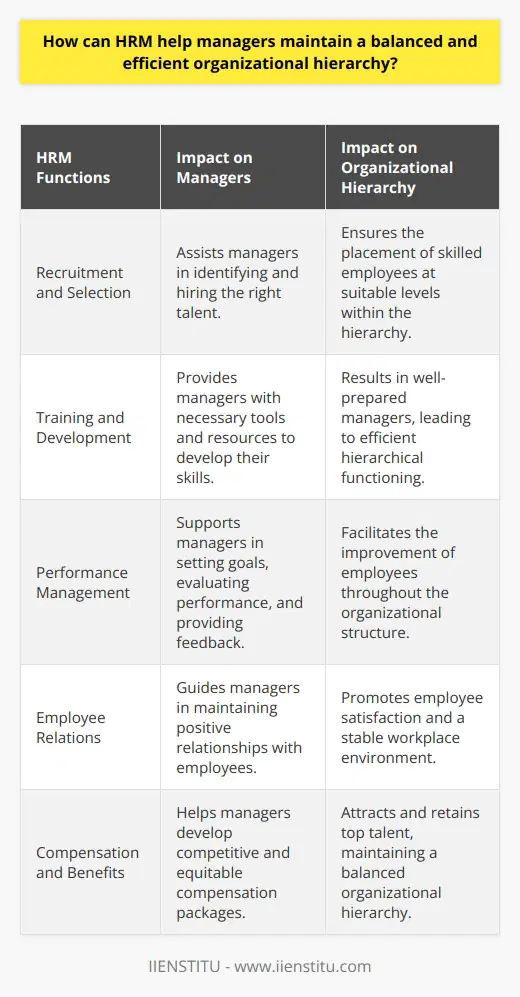
In what ways can HRM contribute to effectively managing an organization's diverse workforce?
Workforce Diversity Management
HRM can effectively manage an organization's diverse workforce through strategic planning and policy making. Proper plans provide direction and express expectations regarding diversity. These include policies on discrimination, harassment, and equal employment opportunities that reflect the organization's commitment to diversity.
Improved Training and Development
HR provide diversity training to educate employees about the benefits of diversity and how to leverage it. They equip workers with the skills, knowledge, and attitudes necessary to work effectively in a diverse environment. Moreover, HR can encourage intercultural competence through foreign language training, cultural immersion experiences, and global leadership development programs.
Recruitment and Selection Strategy
HR ensures a diverse workforce through an effective recruitment and selection strategy. By casting a wider net, they can harness a pool of diverse talent from where they select the best candidates. This approach aims at enhancing diversity at the entry level, which ultimately propagates throughout the organization.
Performance Management and Employee Relations
HR's role in managing employee performance obliges them to ensure fair treatment for all employees. They put measures in place that prohibit biased feedback and evaluations. Additionally, HR permeates a culture of acceptance, promotes open and respectful communication, and maintains positive relations between employees.
Accommodation of Diversity
HR can accommodate diversity by allowing flexible working arrangements. Such measures recognize the different needs and lifestyles of a diverse workforce and better cater to them. Further, HR can provide amenities such as prayer rooms or breastfeeding stations to respect and accommodate employees’ cultural or lifestyle requirements.
In conclusion, human resource management plays a key role in effectively managing an organization's diverse workforce. By adopting strategic policies, providing diversity training, overhauling recruitment strategies, ensuring fairness in performance management, and accommodating diverse needs, HR can help build an inclusive, flexible, and respectful workplace environment.
